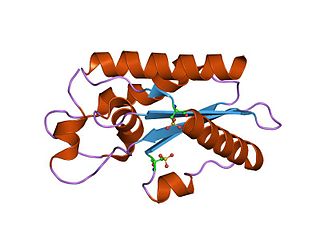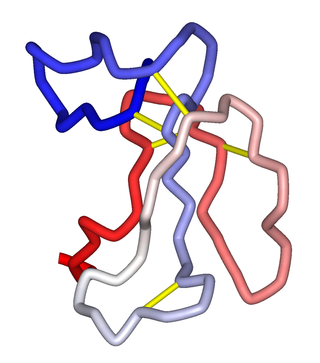Related Research Articles

Smooth muscle is an involuntary non-striated muscle, so-called because it has no sarcomeres and therefore no striations. It is divided into two subgroups, single-unit and multiunit smooth muscle. Within single-unit muscle, the whole bundle or sheet of smooth muscle cells contracts as a syncytium.

Agkistrodon is a genus of venomous pit vipers commonly known as American moccasins. The genus is endemic to North America, ranging from the Southern United States to northern Costa Rica. Eight species are currently recognized, all of them monotypic and closely related. Common names include: cottonmouths, copperheads, and cantils.

A conotoxin is one of a group of neurotoxic peptides isolated from the venom of the marine cone snail, genus Conus.
Ophanin is a toxin found in the venom of the King Cobra, which lives throughout South East Asia. This toxin belongs to the cysteine-rich secretory protein (CRISP) family. Ophanin weakly blocks the contraction of smooth muscles elicited by high potassium-induced depolarization, suggesting that it inhibits voltage-dependent calcium channels.
A latrotoxin is a high-molecular mass neurotoxin found in the venom of spiders of the genus Latrodectus as well as at least one species of another genus in the same family, Steatoda nobilis. Latrotoxins are the main active components of the venom and are responsible for the symptoms of latrodectism.

Gloydius blomhoffii, commonly known as the mamushi, Japanese moccasin, Japanese pit viper, Qichun snake, Salmusa or Japanese mamushi, is a venomous pit viper species found in Japan. It was once considered to have 4 subspecies, but it is now considered monotypic.
Taicatoxin (TCX) is a snake toxin that blocks voltage-dependent L-type calcium channels and small conductance Ca2+-activated K+ channels. The name taicatoxin (TAIpan + CAlcium + TOXIN) is derived from its natural source, the taipan snake, the site of its action, calcium channels, and from its function as a toxin. Taicatoxin was isolated from the venom of Australian taipan snake, Oxyuranus scutellatus scutellatus. TCX is a secreted protein, produced in the venom gland of the snake.

Calciseptine (CaS) is a natural neurotoxin isolated from the black mamba Dendroaspis p. polylepis venom. This toxin consists of 60 amino acids with four disulfide bonds. Calciseptine specifically blocks L-type calcium channels, but not other voltage-dependent Ca2+ channels such as N-type and T-type channels.

Crotamine is a toxin present in the venom of the South American rattlesnake. It is a 42-residue long protein containing 11 basic residues and 6 cysteines. It has also been isolated from the venom of North American prairie rattlesnake, Crotalus viridis viridis. It was first isolated and purified by Brazilian scientist José Moura Gonçalves, and later intensively studied by his group of collaborators at the Medical School of Ribeirão Preto of the University of São Paulo.
Ablomin is a toxin present in the venom of the Japanese Mamushi snake, which blocks L-type voltage-gated calcium channels.
Triflin is a cysteine-rich secretory protein (CRISP), which is excreted by the venom gland of the Habu snake. Triflin reduces high potassium-induced smooth muscle contraction, suggesting a blocking effect on L-type calcium channels.
Latisemin is a cysteine-rich secretory protein that can be isolated from the venom of the Black-banded sea krait, a sea snake indigenous to the warmer waters of the western Pacific Ocean. It is a toxin that inhibits cyclic nucleotide-gated ion channels and blocks L-type calcium channels, thereby reducing smooth muscle contraction.

Cysteine-rich secretory proteins, often abbreviated as CRISPs, are a group of glycoproteins. They are a subgroup of the CRISP, antigen 5 and Pr-1 (CAP) protein superfamily and also contain a domain related to the ShK toxins. They are substantially implicated in the functioning of the mammalian reproductive system. CRISPs are also found in a variety of snake venoms where they inhibit both smooth muscle contraction and cyclic nucleotide-gated ion channels.

The CAP superfamily is a large superfamily of secreted proteins that are produced by a wide range of organisms, including prokaryotes and non-vertebrate eukaryotes.
Helothermine is a toxin from the venom of the Mexican beaded lizard Heloderma horridum horridum. Helothermine inhibits ryanodine receptors, calcium channels and potassium channels. Helothermine can cause lethargy, partial paralysis of rear limbs and lowering of the body temperature.

α-Neurotoxins are a group of neurotoxic peptides found in the venom of snakes in the families Elapidae and Hydrophiidae. They can cause paralysis, respiratory failure, and death. Members of the three-finger toxin protein family, they are antagonists of post-synaptic nicotinic acetylcholine receptors (nAChRs) in the neuromuscular synapse that bind competitively and irreversibly, preventing synaptic acetylcholine (ACh) from opening the ion channel. Over 100 α-neurotoxins have been identified and sequenced.
Huwentoxins (HWTX) are a group of neurotoxic peptides found in the venom of the Chinese bird spider Haplopelma schmidti. The species was formerly known as Haplopelma huwenum, Ornithoctonus huwena and Selenocosmia huwena. While structural similarity can be found among several of these toxins, HWTX as a group possess high functional diversity.
Tamulotoxin is a venomous neurotoxin from the Indian Red Scorpion.

Three-finger toxins are a protein superfamily of small toxin proteins found in the venom of snakes. Three-finger toxins are in turn members of a larger superfamily of three-finger protein domains which includes non-toxic proteins that share a similar protein fold. The group is named for its common structure consisting of three beta strand loops connected to a central core containing four conserved disulfide bonds. The 3FP protein domain has no enzymatic activity and is typically between 60-74 amino acid residues long. Despite their conserved structure, three-finger toxin proteins have a wide range of pharmacological effects. Most members of the family are neurotoxins that act on cholinergic intercellular signaling; the alpha-neurotoxin family interacts with muscle nicotinic acetylcholine receptors (nAChRs), the kappa-bungarotoxin family with neuronal nAChRs, and muscarinic toxins with muscarinic acetylcholine receptors (mAChRs).
GTx1-15 is a toxin from the Chilean tarantula venom that acts as both a voltage-gated calcium channel blocker and a voltage-gated sodium channel blocker.
References
This article lacks ISBNs for the books listed in it.(October 2010) |
- 1 2 3 4 Yamazaki, Yasuo; Hyodo, Fumiko; Morita, Takashi (2003). "Wide distribution of cysteine-rich secretory proteins in snake venoms: Isolation and cloning of novel snake venom cysteine-rich secretory proteins". Archives of Biochemistry and Biophysics. 412 (1): 133–41. doi:10.1016/S0003-9861(03)00028-6. PMID 12646276.
- ↑ Campbell, J.A., & Lamar, W. W. (2004). The Venomous Reptiles of the Western Hemisphere. Ithaca and London:Comstock Publishing Associates. Vol. II, p. 271.
- 1 2 3 4 5 Yamazaki, Yasuo; Morita, Takashi (2004). "Structure and function of snake venom cysteine-rich secretory proteins". Toxicon. 44 (3): 227–31. doi:10.1016/j.toxicon.2004.05.023. PMID 15302528.
- ↑ Guo, Min; Teng, Maikun; Niu, Liwen; Liu, Qun; Huang, Qingqiu; Hao, Quan (2004). "Crystal Structure of the Cysteine-rich Secretory Protein Stecrisp Reveals That the Cysteine-rich Domain Has a K+ Channel Inhibitor-like Fold". Journal of Biological Chemistry. 280 (13): 12405–12. doi: 10.1074/jbc.M413566200 . PMID 15596436.
- ↑ "Piscivorin". UniProt Consortium. 2010. Retrieved 27 October 2010.